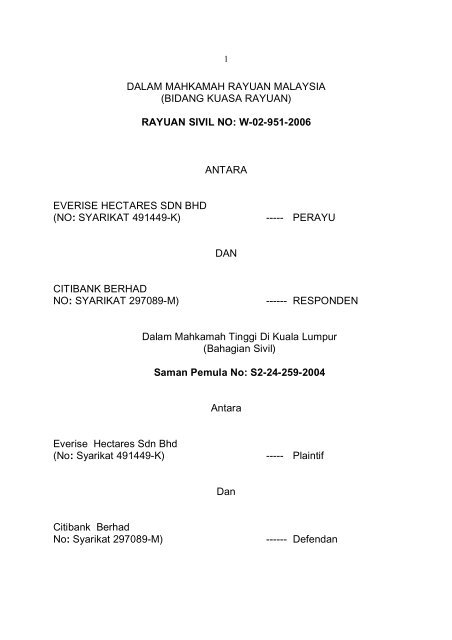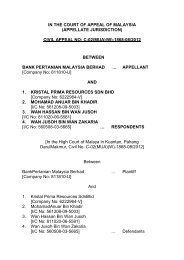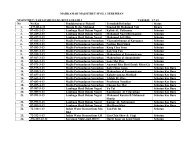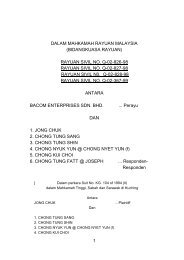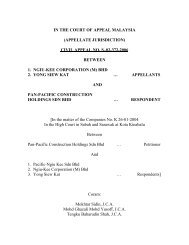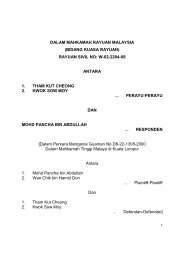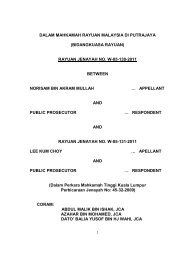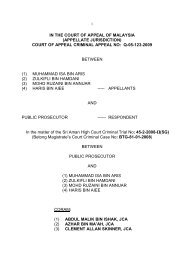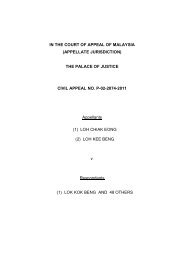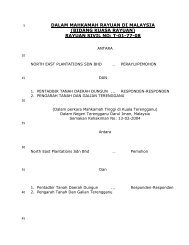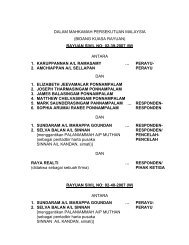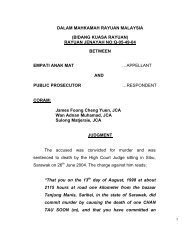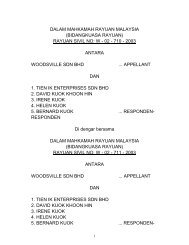rayuan sivil no: w-02-951-2006 antara everise hectares sdn bhd
rayuan sivil no: w-02-951-2006 antara everise hectares sdn bhd
rayuan sivil no: w-02-951-2006 antara everise hectares sdn bhd
You also want an ePaper? Increase the reach of your titles
YUMPU automatically turns print PDFs into web optimized ePapers that Google loves.
1<br />
DALAM MAHKAMAH RAYUAN MALAYSIA<br />
(BIDANG KUASA RAYUAN)<br />
RAYUAN SIVIL NO: W-<strong>02</strong>-<strong>951</strong>-<strong>2006</strong><br />
ANTARA<br />
EVERISE HECTARES SDN BHD<br />
(NO: SYARIKAT 491449-K) ----- PERAYU<br />
DAN<br />
CITIBANK BERHAD<br />
NO: SYARIKAT 297089-M) ------ RESPONDEN<br />
Dalam Mahkamah Tinggi Di Kuala Lumpur<br />
(Bahagian Sivil)<br />
Saman Pemula No: S2-24-259-2004<br />
Antara<br />
Everise Hectares Sdn Bhd<br />
(No: Syarikat 491449-K) ----- Plaintif<br />
Dan<br />
Citibank Berhad<br />
No: Syarikat 297089-M) ------ Defendan
Introduction<br />
CORAM:<br />
2<br />
(1) ABDUL MALIK BIN ISHAK, JCA<br />
(2) MOHD HISHAMUDDIN MOHD YUNUS, JCA<br />
(3) KANG HWEE GEE, JCA<br />
ABDUL MALIK BIN ISHAK, JCA<br />
DELIVERING THE JUDGMENT OF THE COURT<br />
[1] The appellant (Everise Hectares Sdn Bhd) applied by way of a<br />
summons in chambers dated 5.7.2005 to amend the originating summons<br />
to add Fe<strong>no</strong>mena Kualiti Sdn Bhd as the second defendant (hereinafter<br />
referred to as the “amendment application”) and, at the same time, to<br />
prevent the proposed second defendant from taking possession or dealing<br />
with the bungalow land at Lot number DIB 21, Kelab Golf Sultan Abdul Aziz<br />
Shah, phase 2, Selangor held under a master title vide HS(D) 59439, PT<br />
<strong>no</strong>: 286, Mukim Damansara, daerah Petaling, Negeri Selangor (hereinafter<br />
referred to as the “said land”).<br />
[2] On 11.8.<strong>2006</strong>, the learned High Court judge dismissed the<br />
amendment application. Aggrieved, the appellant appealed to this court<br />
[3] The respondent bank (Citibank Berhad) vehemently opposed<br />
the present appeal before us.
The background facts<br />
3<br />
[4] The appellant secured a housing loan in the sum of RM1.5<br />
million for the purpose of purchasing the said land from the respondent<br />
bank. The appellant defaulted and the respondent bank decided to sell the<br />
said land by way of a public auction.<br />
[5] On 14.2.2004, the appellant filed an application for an injunction<br />
(hereinafter referred to as the “first injunction application”) to prevent<br />
the respondent bank from proceeding with the public auction of the said<br />
land.<br />
[6] All the relevant issues pertaining to the first injunction application<br />
were ventilated by the parties fully before the learned High Court judge.<br />
Affidavits and written submissions were also filed in respect of the first<br />
injunction application.<br />
[7] On 17.8.2004, the learned High Court judge heard the first<br />
injunction application and his Lordship dismissed it with costs.<br />
[8] Since the path was clear, the respondent bank proceeded with<br />
the public auction of the said land. This was on 8.11.2004. And the said<br />
land was successfully sold by way of a public auction to Fe<strong>no</strong>mena Kualiti<br />
Sdn Bhd at the price of RM1,548,603.00.<br />
[9] Zakir Basree bin Abdul Rahman affirmed an affidavit on<br />
5.7.2005. From his affidavit at paragraphs 5 and 6, it was deposed that
4<br />
the appellant was aware of the date of the public auction and had sent an<br />
agent to attend but the appellant’s agent did <strong>no</strong>t participate in the public<br />
auction exercise.<br />
[10] When the said land was finally auctioned off to to Fe<strong>no</strong>mena<br />
Kualiti Sdn Bhd on 8.11.2004, the appellant remained passive and idle and<br />
took exactly 7 months 27 days to file the amendment application on<br />
5.7.2005.<br />
[11] The written grounds of judgment of the learned High Court judge<br />
set out in extenso as to why his Lordship dismissed the amendment<br />
application and we can do <strong>no</strong> better than to make reference to them. This<br />
was what his Lordship said:<br />
(a) That the grounds in support of the amendment application were<br />
similar to the grounds raised in the first injunction application<br />
which had already been decided by the High Court. Thus, the<br />
issues raised in the amendment application were res judicata. In<br />
any event, the appellant did <strong>no</strong>t appeal against the dismissal of<br />
the first injunction application.<br />
(b) That the amendment application was made in bad faith and<br />
constituted an abuse of the process of the court because it<br />
indirectly sought to prevent the respondent bank from exercising
5<br />
its legal right to dispose of the said land by way of a public<br />
auction.<br />
(c) There was a delay in filing the amendment application and the<br />
reason given for the delay was unreasonable.<br />
(d) That the amendment application was <strong>no</strong>t filed bona fide because<br />
it sought to deprive the respondent bank of the fruit of its litigation<br />
when the respondent bank succeeded in the first injunction<br />
application.<br />
The issues raised in the amendment application are res judicata<br />
[12] As stated, the amendment application sought for two prayers.<br />
Firstly, to add Fe<strong>no</strong>mena Kualiti Sdn Bhd as the second defendant.<br />
Secondly, to prevent and to injunct the proposed second defendant from<br />
taking possession and/or dealing with the said land.<br />
[13] Clearly by way of the amendment application the appellant<br />
sought for a second injunction over the said land although the first<br />
injunction application had been dismissed on 17.8. 2004 and the appellant<br />
chose <strong>no</strong>t to appeal against its dismissal.<br />
[14] In our judgment, the doctrine of res judicata ought to apply in<br />
favour of the respondent.<br />
[15] Gopal Sri Ram JCA (later FCJ) writing for this court in<br />
Hartecon JV Sdn Bhd & A<strong>no</strong>r v Hartela Contractors Ltd [1996] 2 MLJ
6<br />
57, CA, had this to say about the principle of res judicata at pages 65 to 66<br />
of the report:<br />
“lf authority is needed for the proposition which has commended<br />
itself to us, it is to be found in Government of Malaysia v Dato Chong<br />
Kok Lim [1973] 2 MLJ 74 which was drawn to the attention of counsel<br />
during argument and in which there appears the following passage<br />
in the judgment of Sharma J (at p 76):<br />
In Satyadhyan Ghosel & Ors v Sint Deorajin Dobi and a<strong>no</strong>ther AIR<br />
1960 SC 941, the statement of the law on the subject is given thus:<br />
‘The principle of res judicata is based on the need of giving a finality to<br />
judicial decisions. What it says is that once a res is judicata, it shall be<br />
<strong>no</strong>t adjudged again. Primarily it applies as between past litigation and<br />
future litigation. When a matter – whether on a question of fact or a<br />
question of law – has been decided between two parties in one suit or<br />
proceeding and the decision is final, either because <strong>no</strong> appeal was<br />
taken to a higher court or because the appeal was dismissed, or <strong>no</strong><br />
appeal lies, neither party will be allowed in a future suit or proceeding<br />
between the same parties to canvass the matter again. This principle of<br />
res judicata is embodied in relation to suits in s 11 of the Code of Civil<br />
Procedure; but even where s 11 does <strong>no</strong>t apply, the principle of res<br />
judicata has been applied by courts for the purpose of achieving finality<br />
in litigation. The result of this is that the original court as well as any<br />
higher court must in any future litigation proceed on the basis that the<br />
previous decision was correct.<br />
The principle of res judicata applies also as between two stages in the<br />
same litigation to this extent that a court, whether the trial court or a<br />
higher court having at an earlier stage decided a matter in one way will<br />
<strong>no</strong>t allow the parties to re-agitate the matter again at a subsequent<br />
stage of the same proceedings.’<br />
A decision given by a court at one stage on a particular matter or<br />
issue is binding on it at a later stage in the same suit or in a<br />
subsequent suit. (See Peareth v Marriott [1883] 22 Ch D 182, Hook v<br />
Administrator-General of Bengal & Ors LR 48 IA 187 and Re Trusts of<br />
the Will of Tan Tye (Deceased) Yap Liang Neo v Tan Yew Ghee and<br />
A<strong>no</strong>ther [1936] MLJ 141 at pp 147-151). Parties can<strong>no</strong>t raise a<br />
second time in the same suit an issue that has already been<br />
determined either expressly or by necessary implication. (See Louis<br />
Dreyfus v Aruna Chalayya LR 58 IA 381).”<br />
[16] Low Hop Bing J (<strong>no</strong>w JCA) while sitting on the High Court bench<br />
had occasion to lay down the principles of res judicata in Dato’ Hari
7<br />
Me<strong>no</strong>n @ Dato’ T Puraharan a/l CP Ramakrishnan (suing as legal<br />
representative of DYMM Tuanku Ja’afar Ibni Almarhum Tuanku Abdul<br />
Rahman, Yang Di Pertuan Besar Negeri Sembilan Darul Khusus) v<br />
Texas Encore LLC & Ors [2005] 4 MLJ 506, at pages 516 to 518, in these<br />
trenchant terms:<br />
“lV RES JUDICATA<br />
[23] It was argued for the plaintiff that, at the hearing of encl 9 filed<br />
by the plaintiff to continue the inter partes injunction, and enclosure<br />
(12) filed by the defendant to set it aside, D4 has raised plaintiff’s<br />
locus standi and the jurisdiction of the court, and that on 19 June<br />
20<strong>02</strong>, Muhamad Ideres J had allowed encl 9 and dismissed encl 12<br />
(‘the two decisions’). D4’s appeals against the two decisions are<br />
<strong>no</strong>w pending in the Court of Appeal and that, in so far as the High<br />
Court is concerned, the issues viz locus standi and jurisdiction are<br />
res judicata and D4 is estopped from raising them here. The<br />
following cases were cited:<br />
(1) Keet Gerald Francis Noel John v Mohd Noor bin Abdullah<br />
& Ors [1995] 1 MLJ 193;<br />
(2) Sarkawi bin Sadijo (t/a Jojo’s Musical and Promotion<br />
House) v BMG Music (M) Sdn Bhd & Ors [1996] 4 MLJ 515;<br />
(3) Kuantan Kuala Lumpur Express Omnibus Co Ltd v Utama<br />
Express Sdn Bhd [1986] 1 MLJ 192;<br />
(4) Hartecon JV Sdn Bhd & A<strong>no</strong>r v Hartela Contractors Ltd<br />
[1996] 2 MLJ 57; and<br />
(5) Kewangan Utama Bhd v Cassells Sdn Bhd A<strong>no</strong>r [1998]<br />
MLJU 500.<br />
[24] D4’s response is that the issues of locus standi and<br />
jurisdiction are <strong>no</strong>t res judicata as D4’s instant application in encl 26<br />
is independent of encl 9 and 12, relying on:<br />
(1) Keet Gerald Francis Noel John v Mohd Noor bin Abdullah<br />
& Ors [1995] 1 MLJ 193;<br />
(2) Si Rusa Beach Resort Sdn Bhd v Asia Pacific Hotels<br />
Management Pte Ltd [1985] 1 MLJ 132, 135;
8<br />
(3) Mohamed Zainuddin bin Puteh v Yap Chee Seng [1978] 1<br />
MLJ 40, 42;<br />
(4) Tara Rajaratnam v Datuk Jaginder Singh & Ors [1981] 232,<br />
234;<br />
(5) Lee Sem Yoong v Leong Yoong [1967] 2 MLJ 86;<br />
(6) Cheng Hang Guan & Ors v Perumahan Farlim (Penang)<br />
Sdn Bhd & Ors [1993] 3 MLJ 352, 355;<br />
(7) Perumahan Farlim (Pg) Sdn Bhd & Ors v Cheng Hang<br />
Guan & Ors [1989] 3 MLJ 223, 226; and<br />
(8) Mothercare Ltd v Robson Books Ltd [1979] FSR 466.<br />
[25] At this juncture, it is appropriate for me to put in place the<br />
relevant principles relating to ‘res judicata’ and ‘issue estoppel’<br />
which I shall refer to interchangeably.<br />
[26] Authorities abound in explaining what these expressions mean.<br />
It is enlightening to embark on a discussion of some of these<br />
authorities.<br />
[27] In Perspective Management Services Sdn Bhd v Sega<strong>no</strong>m Sdn<br />
Bhd [2004] 6 AMR 833, Mokhtar Sidin JCA in delivering the majority<br />
judgment of the Court of Appeal revisited this doctrine as expounded<br />
by the courts in India, England and Malaysia, where his Lordship<br />
referred to the position as explained by Peh Swee Chin FCJ (as he<br />
then was) in Asia Commercial Finance (M) Bhd v Kawal Teliti Sdn<br />
Bhd [1995] 3 MLJ 189 at p 197H-I, as follows:<br />
‘What is res judicata? It simply means a matter adjudged, and its<br />
significance lies in its effect of creating an estoppel per rem<br />
judicatum. When a matter between two parties has been adjudicated<br />
by a court of competent jurisdiction, the parties and their privies are<br />
<strong>no</strong>t permitted to litigate once more the res judicata, because the<br />
judgment becomes the truth between such parties, or in other words,<br />
the parties should accept it as the truth; res judicata pro veritate<br />
accipitur. The public policy of the law is that, it is in the public<br />
interest that there should be finality in litigation – interest rei<br />
publicae ut sit finis litium.’<br />
[28] In Hartecon the Court of Appeal, through the judgment of Gopal<br />
Sri Ram JCA at pp 65H to 66C, referred to the judgment of Sharma J<br />
at p 76 in Government of Malaysia v Dato Chong Kok Lim [1973] 2<br />
MLJ 74 and the judgment of the Indian Supreme Court in Satyadhyan
9<br />
Ghosel & Ors v Sint Deorajin Dobi and A<strong>no</strong>r AIR 1960 SC 941 which<br />
stated the law on the subject as follows:<br />
‘The principle of res judicata is based on the need of giving a finality to<br />
judicial decisions. What it says is that once a res is judicata, it shall be<br />
<strong>no</strong>t adjudged again.<br />
The principle of res judicata applies also as between two stages in the<br />
same litigation to this extent that a court whether the trial court or a<br />
higher court having at an earlier stage decided a matter in one way will<br />
<strong>no</strong>t allow the parties to re-agitate the matter again at a subsequent<br />
stage of the same proceedings.’<br />
[29] Parties are therefore bound by the doctrine of res judicata from<br />
re-agitating an issue that had been resolved in earlier proceedings.”<br />
[17] I too while sitting on the High Court bench had occasion to<br />
ventilate my views about the principle of locus standi in Sarkawi bin Sadijo<br />
(t/a Jojo’s Musical and Promotion House) v BMG Music (M) Sdn Bhd &<br />
Ors [1996] 4 MLJ 515, at page 530 in this way:<br />
“It was obvious, so submitted Mr Valen, that the plaintiff had <strong>no</strong><br />
locus standi to sue the defendants. Before a party can sue in an<br />
action he must have locus standi. A party may have a cause of<br />
action but if he has <strong>no</strong> locus standi to initiate the action the court<br />
will, without hesitation, dismiss the action in limine. This seems to<br />
be the stand of the then Supreme Court in the case of the<br />
Government of Malaysia v Lim Kit Siang [1988] 2 MLJ 12, where<br />
Salleh Abas LP (as he then was) speaking for the then Supreme<br />
Court lucidly remarked at p 20 that:<br />
‘Every legal system has a built-in mechanism to protect its judicial<br />
process from abuse by busybodies, cranks and other mischief-makers<br />
by insisting that a plaintiff should have a special interest in the<br />
proceedings which he institutes. This special interest is a nexus<br />
between him and the party against whom he brings his complaints to<br />
court and is k<strong>no</strong>wn as ‘locus standi’.’<br />
It is germane to mention here that the judgment of Idris Yusof J in<br />
Tengku Jaafar bin Tengku Ahmad v Karpal Singh [1993] 3 MLJ 156<br />
on locus standi makes for interesting reading.<br />
It is my judgment that on the facts as highlighted by Mr Valen, the<br />
plaintiff has <strong>no</strong> locus standi to pursue the matter against the
10<br />
defendants and, consequently, there is <strong>no</strong> bona fide serious issue to<br />
be tried.”<br />
[18] We <strong>no</strong>w proceed to set out by way of a comparison the issues<br />
raised by the appellant for the second time in its amended application with<br />
the issues raised in the affidavits and the written submissions of the<br />
appellant in its first injunction application:<br />
(a) That the charge or equitable charge is in the form of an<br />
assignment. However, this issue was adequately addressed by<br />
the respondent bank in opposing the first injunction application.<br />
(b) That the security document is void under section 24 of the<br />
Contracts Act 1950. This issue had been previously raised and<br />
dealt with.<br />
(c) That there has been a contravention of section 214 of the<br />
National Land Code 1965. The appellant contended that the<br />
assignment amounted to a transfer under section 214 of the<br />
National Land Code 1965. However, this issue was adequately<br />
addressed by the respondent bank in opposing the first injunction<br />
application.<br />
(d) Whether the respondent bank was entitled to dispose of the said<br />
land by way of a public auction? This was one of the main<br />
issues raised in the first injunction application. The learned High
11<br />
Court judge had in fact held that the appellant could <strong>no</strong>t raise this<br />
issue again as the High Court had on 17.8.2004 already decided<br />
that the respondent bank was entitled to proceed with the public<br />
auction when the first injunction application was dismissed. It<br />
must be recalled that the first injunction application which sought<br />
to prevent the respondent bank from disposing of the said land<br />
by way of a public auction was dismissed. Thus, the High Court<br />
has decided that the respondent bank was entitled in law to<br />
proceed with the public auction.<br />
(e) That the respondent bank should have registered the charge<br />
and also dispose of the said land in accordance with Order 83 of<br />
the Rules of the High Court. This issue was raised by the<br />
appellant in the first injunction application. And it was adequately<br />
addressed by the respondent bank.<br />
[19] To compound the matter further, the learned High Court judge<br />
found that the following issues sought to be raised in the amendment<br />
application had been raised by the appellant in the first injunction and they<br />
could <strong>no</strong>t be raised again as they were res judicata:<br />
(a) that the charge over the said land is void;<br />
(b) that the agreement is void under section 24 of the Contracts Act<br />
1950;
12<br />
(c) that section 214 of the National Land Code 1965 has been<br />
contravened; and<br />
(d) the right of the respondent to auction the said land was <strong>no</strong>t in<br />
accordance with the provisions of the National Land Code 1965.<br />
[20] One of the theories on which the doctrine of res judicata is<br />
based is the finality and conclusiveness of judicial decisions where a party<br />
is unable to impeach the correctness of a judgment delivered by a<br />
competent court save by way of an appeal. To put it in a<strong>no</strong>ther way, where<br />
issues, factual or legal, have already been determined in previous<br />
proceedings neither the parties <strong>no</strong>r their privies will be allowed to re-litigate<br />
those issues in subsequent proceedings (Ashmore v. British Coal<br />
Corporation [1990] 2 QB 338, CA; and Kirin-Amgen Inc. & A<strong>no</strong>ther v.<br />
Boehringer Mannheim Gmbh & A<strong>no</strong>ther; Boehringer Mannheim Gmbh<br />
& A<strong>no</strong>ther v. Jannsen-Cilag Limited [1997] 24 FSR 289, CA).<br />
[21] When you talk about “privies”, Lord Reid in Carl Zeiss<br />
Stiftung v. Rayner & Keeler Ltd. And Others; Rayner & Keeler Ltd. And<br />
Others v. Courts And Others [1967] 1 AC 853, HL, said at page 910<br />
that “there must be privity of blood, title or interest: here it would have<br />
to be privity of interest.”<br />
[22] A judicial determination directly involving an issue of fact or<br />
law disposes once and for all the issue, so that it can<strong>no</strong>t afterwards be
13<br />
raised between the same parties or their privies. Now, the estoppel covers<br />
only those matters which the prior judgment, decree or order necessarily<br />
established as the legal foundation or justification of its conclusion.<br />
[23] Res judicata prevents the re-agitation of the same cause of<br />
action in later proceedings (Jackson v. Goldsmith [1950] 81 CLR 446 at<br />
447; and Ramsay v. Pigram [1968-1969] 118 CLR 271 at 280). But the<br />
question to pose is this: what amounts to a cause of action? In Port of<br />
Melbourne Authority v. Anshun Proprietary Limited [1980-1981] 147<br />
CLR 589, 610, Brennan J said the term is used to refer to:<br />
(a) the series of facts which the plaintiff must allege and prove to<br />
substantiate a right to judgment;<br />
(b) the legal right which has been infringed; and<br />
(c) the substance of the action, as distinct from its form.<br />
[24] The observations of Wigram VC in Henderson v. Henderson<br />
[1843] 3 Hare 100, at pages 114 to 115, should be referred to:<br />
“l believe I state the rule of the Court correctly when I say that,<br />
where a given matter becomes the subject of litigation in, and of<br />
adjudication by, a court of competent jurisdiction, the Court requires<br />
the parties to that litigation to bring forward their whole case, and<br />
will <strong>no</strong>t (except under special circumstances) permit the same<br />
parties to open the same subject of litigation in respect of matter<br />
which might have been brought forward as part of the subject in<br />
contest, but which was <strong>no</strong>t brought forward, only because they<br />
have, from negligence, inadvertence, or even accident, omitted part<br />
of their case. The plea of res judicata applies, except in special<br />
cases, <strong>no</strong>t only to points upon which the Court was actually<br />
required by the parties to form an opinion and pro<strong>no</strong>unce a<br />
judgment, but to every point which properly belonged to the subject
14<br />
of litigation, and which the parties, exercising reasonable diligence,<br />
might have brought forward at the time.”<br />
[25] Applying all these salient principles to the present appeal at<br />
hand, it is crystal clear that the issues sought to be raised by the appellant<br />
in the amendment application have already been raised in the first<br />
injunction application. The appellant, in our judgment, can<strong>no</strong>t as a matter<br />
of the law raise these issues for the second time.<br />
[26] As Sharma J said in the Government of Malaysia v. Dato<br />
Chong Kok Lim [1973] 2 MLJ 74, at page 76:<br />
76):<br />
“The subject of the ground of attack in Enclosure 9 fully covers the<br />
subject of attack in Enclosure 33 and, therefore, in my view, the<br />
defendant is barred from reagitating the same or a part of the same<br />
matter which has already been finally adjudicated upon by Mr.<br />
Justice Chang Min Tat. The defendant did <strong>no</strong>t appeal against that<br />
decision and so far as Enclosure 9 is concerned the judgment of Mr.<br />
Justice Chang Min Tat, in my view, is final and conclusive at this<br />
stage of the proceedings.”<br />
[27] And his Lordship Sharma J continued to say that (see page<br />
“The rule is that a matter which might and ought to have been made<br />
a ground of attack or defence becomes a matter which was<br />
constructively in issue. A matter which might and ought to have<br />
been made a ground of attack or defence in the former application<br />
but which was <strong>no</strong>t alleged as such a ground of attack or defence is<br />
for the purposes of the plea of res judicata deemed to have been a<br />
matter directly and substantially in issue in the former application,<br />
that is to say, though it may <strong>no</strong>t have been actually directly and<br />
substantially in issue it is still regarded as, having been<br />
constructively, directly and substantially in issue. There can be <strong>no</strong><br />
distinction between a claim that was actually made and a claim<br />
which might and ought to have been made. The plea of res judicata<br />
applies, except in special cases, <strong>no</strong>t only to points on which the
15<br />
court was actually required by the parties to form an opinion and to<br />
pro<strong>no</strong>unce its judgment thereupon but to every point which properly<br />
belonged to the subject of litigation and which the parties exercising<br />
reasonable diligence might have brought forward at the time. It is<br />
only where the plea which is sought to be raised in the subsequent<br />
proceedings was <strong>no</strong>t available to the party at the time of the previous<br />
proceedings that the decision can<strong>no</strong>t be constructively res judicata.<br />
The rule of constructive res judicata is really a rule of estoppel. The<br />
question <strong>no</strong>w raised has already been heard and finally decided.”<br />
The amendment application<br />
[28] We categorically say that this amendment application<br />
constitutes an abuse of the process of the court because the appellant is<br />
indirectly seeking a second injunction to prevent dealings with the said land<br />
although the first injunction application had been dismissed on 17.8.2004.<br />
[29] Since the amendment application can conveniently be<br />
categorised as a useless attempt to attack the outcome of the public<br />
auction, it should <strong>no</strong>t be allowed to succeed. It was an ineffective<br />
amendment application that should be nipped in the bud. In similar vein,<br />
Abdul Razak J in Eshah binti Sa’at v. Meriam binti Sa’at & Ors [1975] 2<br />
MLJ 97 aptly said:<br />
“lt has been held that in dealing with the application for amendment,<br />
the court has to consider the materiality and effectiveness of the<br />
amendment and that it was a well established practice <strong>no</strong>t to allow<br />
an amendment where it appeared such an amendment would be<br />
useless. The court should look at the probable consequence of the<br />
amendment and if the amendment would be ineffectual then it ought<br />
<strong>no</strong>t to be allowed to be made. One such amendment was sought to<br />
be made in Ponnusamy v. Nathu Ram [1959] MLJ 228 and was<br />
refused. Clearly, the amendment here, even if allowed, would be of<br />
<strong>no</strong> value because I would <strong>no</strong>t have been persuaded to grant the<br />
declaration asked for. To have the desired effect, the Collector’s<br />
decision must at least be impugned. An amendment would,
16<br />
therefore, have involved making the Collector a necessary party to<br />
the action with or without the defendant. To allow the application to<br />
amend at the trial stage, therefore, was to make the Collector a party<br />
and binding him without first giving him the right of reply.”<br />
The amendment application was <strong>no</strong>t made bona fide<br />
[30] The learned High Court judge was correct when he held that<br />
the amendment application was <strong>no</strong>t made bona fide.<br />
[31] The delay of 7 months 27 days before the appellant filed the<br />
amendment application on 5.7.2005 showed that there was <strong>no</strong> due<br />
diligence on the part of the appellant.<br />
[32] The delay in applying for an amendment was also considered<br />
by this court in Raphael Pura v. Insas Bhd & A<strong>no</strong>r [2000] 4 CLJ 830. At<br />
page 838, this court had this to say:<br />
“With respect, this is <strong>no</strong> excuse for the appellant to delay the<br />
application for the amendment of his defence at a very late stage<br />
without placing sufficient material before the court and to give<br />
cogent reasons thereof. It should be <strong>no</strong>ted that an application for<br />
amendment of a writ or pleadings is <strong>no</strong>t as a matter of a right of a<br />
party but is left to the judicial discretion of the court depending on<br />
the circumstances of each case. In dealing with the amendment to<br />
the defence, we would quote a passage from Gatley on Libel, 9th<br />
edn. (1998) under the caption ‘Granting of leave in discretion of<br />
court’ at p. 447:<br />
....the court has shown itself reluctant to grant a defendant leave to<br />
amend his defence where the application is made late in the day,<br />
either at, or close to, the trial; (Plummer v. Charman [1962] 1 WLR<br />
1469, CA), in particular, when he seeks to introduce a plea of<br />
justification at a late stage, the defendant’s conduct will be closely<br />
inquired into, and the court will expect him to have shown due<br />
diligence in making his inquiries and investigations (Associated<br />
Leisure v. Associated Newspapers [1970] 2 QB 450, CA). It has been<br />
held that where delay has been due to the defendant’s own default in<br />
some respect, that circumstance should be taken into consideration<br />
by the judge as part of the matters to be weighed in deciding whether
17<br />
or <strong>no</strong>t to allow an amendment. The mere fact that delay may be<br />
capable of being compensated in money is <strong>no</strong>t conclusive of the<br />
question whether the amendment should or should <strong>no</strong>t be permitted<br />
(Bower v. Maxwell, unreported, May 8, 1989, 891472, CA.).”<br />
[33] In Taisho Company Sdn Bhd v. Pan Global Equities Bhd &<br />
A<strong>no</strong>r [1999] 1 CLJ 703, the application for leave to amend was filed 4<br />
years after the action was commenced and the appellant there was aware<br />
of the facts 4 years before the action was filed. There was <strong>no</strong> explanation<br />
for the delay and this court concluded that the application for leave to<br />
amend lacked bona fide.<br />
[34] The lack of bona fide also reflected in the case of Tildesley v.<br />
Harper [1878] 10 Ch D 393, CA. There Bramwell LJ at pages 396 to 397<br />
aptly said:<br />
“My practice has always been to give leave to amend unless I have<br />
been satisfied that the party applying was acting mala fide, or that,<br />
by his blunder, he had done some injury to his opponent which<br />
could <strong>no</strong>t be compensated for by costs or otherwise.”<br />
The filing of the amendment application was a tactical ma<strong>no</strong>euvre<br />
[35] The filing of the amendment application can best be described<br />
as a tactical ma<strong>no</strong>euvre on the part of the appellant to delay and prevent<br />
the respondent bank from completing the sale of the said land to<br />
Fe<strong>no</strong>mena Kualiti Sdn Bhd.
18<br />
[36] Legally speaking, if the appellant intended to prevent the sale<br />
of the said land to Fe<strong>no</strong>mena Kualiti Sdn Bhd, the appellant should have<br />
taken the following steps:<br />
(a) appealed against the dismissal of the first injunction application;<br />
and<br />
(b) applied for an erinford injunction pending the appeal to the Court<br />
of Appeal.<br />
[37] Alas, all these were <strong>no</strong>t done by the appellant. Instead the<br />
appellant filed the amendment application some months after the dismissal<br />
of the first injunction application.<br />
[38] Tactical ma<strong>no</strong>euvrings were frowned upon by the courts in the<br />
following cases.<br />
[39] In Tetuan Tanjung Teras Sdn Bhd & Ors v Tetuan Syn Tai<br />
Hung Trading Sdn Bhd [2003] 4 MLJ 465, where Low Hop Bing J (<strong>no</strong>w<br />
JCA) aptly said at page 471 of the report:<br />
“The defendants’ application herein is made at the appeal stage after<br />
the learned sessions court judge has arrived at a decision upon<br />
consideration of all the pleadings, affidavits and exhibits before him.<br />
It seems to me that this is a tactical ma<strong>no</strong>uevre amounting to an<br />
abuse of the process of the court and should be disallowed: Ismail<br />
bin Ibrahim & Ors v Sum Poh Development Sdn Bhd & A<strong>no</strong>r [1988] 3<br />
MLJ 348.”
19<br />
[40] In Lim Nyang Tak Michael v ACE Tech<strong>no</strong>logies Sdn Bhd<br />
[1995] 4 MLJ 616, where Abdul Kadir Suleiman J (later FCJ) rightly held<br />
that:<br />
“lt was <strong>no</strong>t a question of negligence to plead all those matters in the<br />
original defence but a tactical ma<strong>no</strong>euvre and done in bad faith to<br />
delay the rights of the plaintiff on his claim. The application to<br />
amend the defence after exposure by the plaintiff in his affidavit in<br />
support was a tactic to confuse the issues by creating imaginary<br />
‘triable issues’ and to stall the plaintiff of his rights. If this was<br />
allowed, it would unnecessarily cause prejudice to the plaintiff which<br />
could <strong>no</strong>t be compensated by costs.”<br />
[41] In Ismail bin Ibrahim & Ors v Sum Poh Development Sdn<br />
Bhd & A<strong>no</strong>r [1988] 3 MLJ 348, where Mohamed Dzaiddin J (later Chief<br />
Justice of Malaysia) aptly said:<br />
“The rule governing the amendment of pleadings is that the court<br />
will allow such amendments as will cause <strong>no</strong> injustice to the other<br />
parties. However, there are two circumstances in which an<br />
amendment to add an allegation of fraud would <strong>no</strong>t be permitted: (a)<br />
where the facts giving rise to the plea of fraud were k<strong>no</strong>wn at the<br />
time of the original pleading and (b) where the delay in pleading<br />
fraud was in connection with some tactical ma<strong>no</strong>euvre.”<br />
[42] The general rule that an amendment will be permitted if the<br />
opposing party does <strong>no</strong>t suffer an injustice as a result of the proposed<br />
amendment must be put to the fore (Khoo Tau Guan v Weng Lai Ping &<br />
Others [2003] MLJU 654). But, in exercising its discretion to allow or<br />
disallow a pleading to be amended, the court must consider the position of<br />
all the parties.
20<br />
[43] Here, the resulting prejudice to the respondent bank can<strong>no</strong>t be<br />
compensated by costs because of the appellant’s mala fide in filing the<br />
amendment application after a delay of 7 months and 27 days and the<br />
ma<strong>no</strong>euvrings of the appellant to delay the sale of the said land to<br />
Fe<strong>no</strong>mena Kualiti Sdn Bhd.<br />
The issue of locus standi<br />
[44] This issue was incorporated in the memorandum of appeal.<br />
[45] To say as was said by the appellant that the respondent bank<br />
can<strong>no</strong>t object to the amendment application can<strong>no</strong>t be accepted by this<br />
court. Such a contention is totally baseless and unfounded.<br />
[46] As a party to the suit, the respondent bank has a right to object<br />
to the amendment application. The outcome of the suit would definitely<br />
affect the legal rights of the respondent bank.<br />
[47] The obvious effect of the locus standi rule is to exclude some<br />
people from obtaining the assistance of the courts in declaring and<br />
enforcing the law. That must be the main reason for the appellant to<br />
exclude the respondent bank from participating in the amendment<br />
application by arguing that the respondent bank had <strong>no</strong> locus standi.<br />
[48] The respondent bank has sufficient interest to challenge the<br />
amendment application and has locus standi before this court. In Tan Sri
21<br />
Haji Othman Saat v. Mohamed bin Ismail [1982] 2 MLJ 177, at page<br />
179, Abdoolcadeer J (later SCJ) had this to say:<br />
“The sensible approach in the matter of locus standi in injunctions<br />
and declarations would be as a matter of jurisdiction, an assertion of<br />
an infringment of a contractual or a proprietary right, the<br />
commission of a tort, a statutory right or the breach of a statute<br />
which affects the plaintiff’s interests substantially or where the<br />
plaintiff has some genuine interest in having his legal position<br />
declared, even though he could get <strong>no</strong> other relief, should suffice.”<br />
Issues of bad faith, abuse of the process of the court and the delay<br />
factor<br />
[49] From the available evidence, the learned High Court judge was<br />
entitled to hold that the appellant had acted in bad faith and that there was<br />
an unjustified delay in filing the amendment application and that<br />
amendment application was an abuse of the process of the court.<br />
ig<strong>no</strong>red:<br />
[50] The following impinging factors against the appellant can<strong>no</strong>t be<br />
(a) the proposed amendments in the amendment application, even if<br />
allowed, were bound to fail;<br />
(b) the amendment application was a tactical ma<strong>no</strong>euvre to deprive<br />
the respondent bank of the fruit of its litigation and the failure of<br />
the appellant to appeal against the dismissal of the first injunction<br />
application; and
22<br />
(c) the failure on the part of the appellant to adequately explain the<br />
reason for the delay in filing the amendment application despite<br />
the presence of the appellant’s agent at the public auction.<br />
[51] Based on the available evidence and the relevant materials, the<br />
learned High Court judge rightly exercised his judicial discretion in favour of<br />
the respondent’s bank. We are <strong>no</strong>t inclined to interfere.<br />
Conclusion<br />
[52] For the reasons adumbrated above, we unanimously dismissed<br />
the appeal with costs of RM3,000.00. The deposit should rightly go to the<br />
respondent bank.<br />
20.9.2010 Dato’ Abdul Malik bin Ishak<br />
Judge, Court of Appeal,<br />
Malaysia
Counsel<br />
(1) For the Appellant : Mr Vi<strong>no</strong>d Kamalanathan Ratnam<br />
23<br />
Solicitors : Messrs Vi<strong>no</strong>d Kamalanathan & Associates<br />
Advocates & Solicitors<br />
Kuala Lumpur<br />
(2) For the Respondent : Mr. Rabindra S. Nathan with<br />
Miss Allister Tan<br />
Solicitors : Messrs Shearn Delamore & Co<br />
Advocates & Solicitors<br />
Kuala Lumpur<br />
Cases referred to in this judgment:<br />
(1) Hartecon JV Sdn Bhd & A<strong>no</strong>r v Hartela Contractors Ltd [1996] 2<br />
MLJ 57, CA.<br />
(2) Dato’ Hari Me<strong>no</strong>n @ Dato’ T Puraharan a/l CP Ramakrishnan<br />
(suing as legal representative of DYMM Tuanku Ja’afar Ibni<br />
Almarhum Tuanku Abdul Rahman, Yang DiPertuan Besar Negeri<br />
Sembilan Darul Khusus) v Texas Encore LLC & Ors [2005] 4<br />
MLJU 506.<br />
(3) Sarkawi bin Sadijo (t/a Jojo’s Musical and Promotion House) v<br />
BMG Music (M) Sdn Bhd & Ors [1996] 4 MLJ 515.<br />
(4) Ashmore v. British Coal Corporation [1990] 2 QB 338, CA.
24<br />
(5) Kirin-Amgen Inc. & A<strong>no</strong>ther v. Boehringer Mannheim Gmbh &<br />
A<strong>no</strong>ther; Boehringer Mannheim Gmbh & A<strong>no</strong>ther v. Jannsen-<br />
Cilag Limited [1997] 24 FSR 289, CA).<br />
(6) Carl Zeiss Stiftung v Rayner & Keeler Ltd (No 2) [1967] 1 AC 853.<br />
(7) Jackson v Goldsmith [1950] 81 CLR 446 at 447.<br />
(8) Ramsay v. Pigram [1968-1969] 118 CLR 271 at 280.<br />
(9) Port of Melbourne Authority v. Anshun Proprietary Limited<br />
[1980-1981] 147 CLR 589.<br />
(10) Henderson v. Henderson [1843] 3 Hare 100, 114.<br />
(11) Government of Malaysia v Dato Chong Kok Lim [1973] 2 MLJ 74.<br />
(12) Eshah binti Sa’at v. Meriam binti Sa’at & Ors [1975] 2 MLJ 97.<br />
(13) Raphael Pura v. Insas Bhd & A<strong>no</strong>r [2000] 4 CLJ 830, 838.<br />
(14) Taisho Company Sdn Bhd v. Pan Global Equities Bhd & A<strong>no</strong>r<br />
[1999] 1 CLJ 703.<br />
(15) Tildesley v. Harper [1878] 10 Ch D 393, 396-397, CA.<br />
(16) Tetuan Tanjung Teras Sdn Bhd & Ors v Tetuan Syn Tai Hung<br />
Trading Sdn Bhd [2003] 4 MLJ 465.<br />
(17) Lim Nyang Tak Michael v ACE Tech<strong>no</strong>logies Sdn Bhd [1995] 4<br />
MLJ 616.<br />
(18) Ismail bin Ibrahim & Ors v Sum Poh Development Sdn Bhd &<br />
A<strong>no</strong>r [1988] 3 MLJ 348.<br />
(19) Khoo Tau Guan v Weng Lai Ping & Others [2003] MLJU 654.<br />
(20) Tan Sri Haji Othman Saat v Mohamed bin Ismail [1982] 2 MLJ<br />
177.


